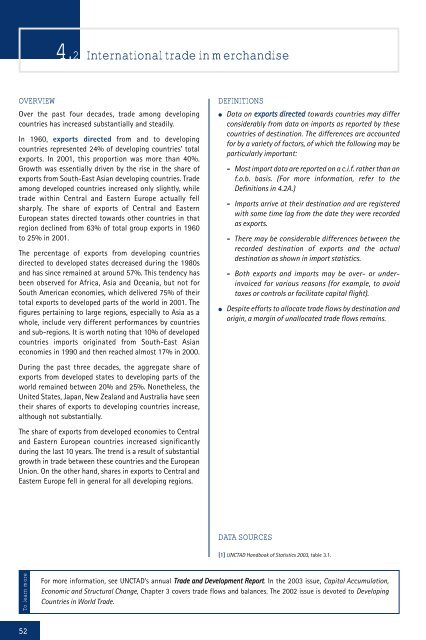Development and Globalization: - Unctad
Development and Globalization: - Unctad
Development and Globalization: - Unctad
You also want an ePaper? Increase the reach of your titles
YUMPU automatically turns print PDFs into web optimized ePapers that Google loves.
OVERVIEW DEFINITIONS<br />
Over the past four decades, trade among developing<br />
countries has increased substantially <strong>and</strong> steadily.<br />
In 1960, exports directed from <strong>and</strong> to developing<br />
countries represented 24% of developing countries’ total<br />
exports. In 2001, this proportion was more than 40%.<br />
Growth was essentially driven by the rise in the share of<br />
exports from South-East Asian developing countries. Trade<br />
among developed countries increased only slightly, while<br />
trade within Central <strong>and</strong> Eastern Europe actually fell<br />
sharply. The share of exports of Central <strong>and</strong> Eastern<br />
European states directed towards other countries in that<br />
region declined from 63% of total group exports in 1960<br />
to 25% in 2001.<br />
The percentage of exports from developing countries<br />
directed to developed states decreased during the 1980s<br />
<strong>and</strong> has since remained at around 57%. This tendency has<br />
been observed for Africa, Asia <strong>and</strong> Oceania, but not for<br />
South American economies, which delivered 75% of their<br />
total exports to developed parts of the world in 2001. The<br />
figures pertaining to large regions, especially to Asia as a<br />
whole, include very different performances by countries<br />
<strong>and</strong> sub-regions. It is worth noting that 10% of developed<br />
countries imports originated from South-East Asian<br />
economies in 1990 <strong>and</strong> then reached almost 17% in 2000.<br />
During the past three decades, the aggregate share of<br />
exports from developed states to developing parts of the<br />
world remained between 20% <strong>and</strong> 25%. Nonetheless, the<br />
United States, Japan, New Zeal<strong>and</strong> <strong>and</strong> Australia have seen<br />
their shares of exports to developing countries increase,<br />
although not substantially.<br />
The share of exports from developed economies to Central<br />
<strong>and</strong> Eastern European countries increased significantly<br />
during the last 10 years. The trend is a result of substantial<br />
growth in trade between these countries <strong>and</strong> the European<br />
Union. On the other h<strong>and</strong>, shares in exports to Central <strong>and</strong><br />
Eastern Europe fell in general for all developing regions.<br />
To learn more<br />
52<br />
4.2 International trade in merch<strong>and</strong>ise<br />
● Data on exports directed towards countries may differ<br />
considerably from data on imports as reported by these<br />
countries of destination. The differences are accounted<br />
for by a variety of factors, of which the following may be<br />
particularly important:<br />
- Most import data are reported on a c.i.f. rather than an<br />
f.o.b. basis. (For more information, refer to the<br />
Definitions in 4.2A.)<br />
- Imports arrive at their destination <strong>and</strong> are registered<br />
with some time lag from the date they were recorded<br />
as exports.<br />
- There may be considerable differences between the<br />
recorded destination of exports <strong>and</strong> the actual<br />
destination as shown in import statistics.<br />
- Both exports <strong>and</strong> imports may be over- or underinvoiced<br />
for various reasons (for example, to avoid<br />
taxes or controls or facilitate capital flight).<br />
● Despite efforts to allocate trade flows by destination <strong>and</strong><br />
origin, a margin of unallocated trade flows remains.<br />
DATA SOURCES<br />
[1] UNCTAD H<strong>and</strong>book of Statistics 2003, table 3.1.<br />
For more information, see UNCTAD’s annual Trade <strong>and</strong> <strong>Development</strong> Report. In the 2003 issue, Capital Accumulation,<br />
Economic <strong>and</strong> Structural Change, Chapter 3 covers trade flows <strong>and</strong> balances. The 2002 issue is devoted to Developing<br />
Countries in World Trade.

















